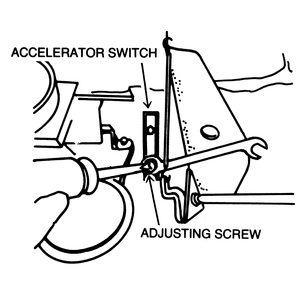- Check the engine idle speed and mixture, and adjust as necessary.
- Remove the air cleaner.
- With the tachometer still connected to the engine, loosen the dashpot locknut.
Move the throttle lever and hold to maintain the engine speed at 2,400–2,600
rpm (2,100–2,300 rpm for California trucks).
- Turn the dashpot until its rod contacts the throttle lever and tighten the
locknut.
- Move the throttle lever until it contacts the dashpot rod and recheck the
engine speed. Repeat the adjustment if necessary.
| Fig. 1: Adjusting the accelerator switch

|
- Be sure that the throttle valve is fully closed.
- Loosen the switch adjusting screw and turn the switch off.
- Gradually tighten the adjusting screw until the switch produces a clicking
sound and is turned on.
- Tighten the adjusting screw another 1 1⁄2 turns.
The accelerator switch is mounted on the arm of the accelerator pedal.
- Check the accelerator pedal to make sure that it moves freely.
- Loosen the accelerator switch locknut.
- Gradually turn the adjusting screw until the accelerator switch clicks.
- Tighten the locknut.
- Warm up the engine until the water temperature is at least 156°F (69°C).
- Make sure that the mixture and idle speed are properly adjusted.
- Adjust the idle speed to 1,075–1,100 rpm on models with manual transmission;
1,200–1,300 rpm on models with automatic transmission, by rotating the
throttle adjusting screw.
- Rotate the idle switch adjusting screw until the switch changes from OFF
to ON position.
- Slowly turn the idle switch adjusting screw back to the point where the
switch just changes from ON to OFF.
- Turn the throttle screw back so that the engine returns to idle.
NOTE: Be sure that the idle switch goes on when the idle
speed is still above 1,000 rpm.

